
ScanSource (SCSC)
We wouldn’t recommend ScanSource. Its low returns on capital and plummeting sales suggest it struggles to generate demand and profits, a red flag.― StockStory Analyst Team
1. News
2. Summary
Why We Think ScanSource Will Underperform
Operating as a crucial link in the technology supply chain since 1992, ScanSource (NASDAQ:SCSC) is a hybrid distributor that connects hardware, software, and cloud services from technology suppliers to resellers and business customers.
- Products and services are facing significant end-market challenges during this cycle as sales have declined by 11.1% annually over the last two years
- Responsiveness to unforeseen market trends is restricted due to its substandard operating margin profitability
- Earnings growth over the last two years fell short of the peer group average as its EPS only increased by 3.8% annually


ScanSource doesn’t measure up to our expectations. There are more appealing investments to be made.
Why There Are Better Opportunities Than ScanSource
High Quality
Investable
Underperform
Why There Are Better Opportunities Than ScanSource
ScanSource’s stock price of $41.36 implies a valuation ratio of 9.8x forward P/E. This is a cheap valuation multiple, but for good reason. You get what you pay for.
Cheap stocks can look like a great deal at first glance, but they can be value traps. They often have less earnings power, meaning there is more reliance on a re-rating to generate good returns - an unlikely scenario for low-quality companies.
3. ScanSource (SCSC) Research Report: Q3 CY2025 Update
Technology distribution company ScanSource (NASDAQ:SCSC) missed Wall Street’s revenue expectations in Q3 CY2025, with sales falling 4.6% year on year to $739.7 million. On the other hand, the company’s full-year revenue guidance of $3.2 billion at the midpoint came in 0.6% above analysts’ estimates. Its non-GAAP profit of $1.06 per share was 14% above analysts’ consensus estimates.
ScanSource (SCSC) Q3 CY2025 Highlights:
- Revenue: $739.7 million vs analyst estimates of $787.4 million (4.6% year-on-year decline, 6.1% miss)
- Adjusted EPS: $1.06 vs analyst estimates of $0.93 (14% beat)
- Adjusted EBITDA: $38.59 million vs analyst estimates of $35.03 million (5.2% margin, 10.2% beat)
- The company reconfirmed its revenue guidance for the full year of $3.2 billion at the midpoint
- EBITDA guidance for the full year is $155 million at the midpoint, above analyst estimates of $150.8 million
- Operating Margin: 3.5%, in line with the same quarter last year
- Free Cash Flow Margin: 2.8%, down from 5.5% in the same quarter last year
- Market Capitalization: $924 million
Company Overview
Operating as a crucial link in the technology supply chain since 1992, ScanSource (NASDAQ:SCSC) is a hybrid distributor that connects hardware, software, and cloud services from technology suppliers to resellers and business customers.
ScanSource serves as a middleman in the technology ecosystem, sourcing products and services from approximately 500 technology suppliers and making them available to around 25,000 customers through multiple sales channels. These channels include value-added resellers (VARs), agents, independent sales organizations (ISOs), and independent software vendors (ISVs).
The company operates through two main business segments. The Specialty Technology Solutions segment focuses on enterprise mobile computing, barcode technology, point-of-sale systems, payment processing, physical security, and networking products. The Modern Communications & Cloud segment offers communications technologies, unified communications, video conferencing, and cloud services.
For example, a retail business might work with a ScanSource VAR to implement a complete point-of-sale system that includes hardware terminals, payment processing capabilities, and inventory management software—all sourced through ScanSource's distribution network.
ScanSource generates revenue by purchasing products from suppliers at volume discounts and selling them to its channel partners. The company has evolved beyond traditional distribution to include recurring revenue streams from hardware rentals, Software as a Service (SaaS), and cloud services. This hybrid model allows ScanSource to offer both one-time product sales and subscription-based technology services.
The company maintains facilities in the United States, Canada, and Brazil, with distribution centers in Mississippi, California, Kentucky, and various locations in Brazil. ScanSource adds value through services like product configuration, technical support, logistics assistance, and channel financial services, helping its partners deliver complete technology solutions to end users across industries including retail, healthcare, education, and government.
4. IT Distribution & Solutions
IT Distribution & Solutions will be buoyed by the increasing complexity of IT ecosystems, rising cloud adoption, and demand for cybersecurity solutions. Enterprises are less likely than ever to embark on these complicated journeys solo, and companies in the sector boast expertise and scale in these areas. However, cloud migration also means less need for hardware, which could dent demand for large portions of the product portfolio and hurt margins. Additionally, planning for potentially supply chain disruptions is ongoing, as the COVID-19 pandemic showed how damaging a pause in global trade could be in areas like semiconductor procurement.
ScanSource competes with broad-line technology distributors such as Ingram Micro and TD Synnex across most of its markets. In specialized segments, it faces competition from security distributors like ADI and Wesco, AIDC and POS distributors like BlueStar, and technology services distributors such as Avant and Telarus.
5. Revenue Growth
A company’s long-term performance is an indicator of its overall quality. Any business can put up a good quarter or two, but the best consistently grow over the long haul.
With $3.00 billion in revenue over the past 12 months, ScanSource is a mid-sized business services company, which sometimes brings disadvantages compared to larger competitors benefiting from better economies of scale.
As you can see below, ScanSource struggled to increase demand as its $3.00 billion of sales for the trailing 12 months was close to its revenue five years ago. This shows demand was soft, a rough starting point for our analysis.
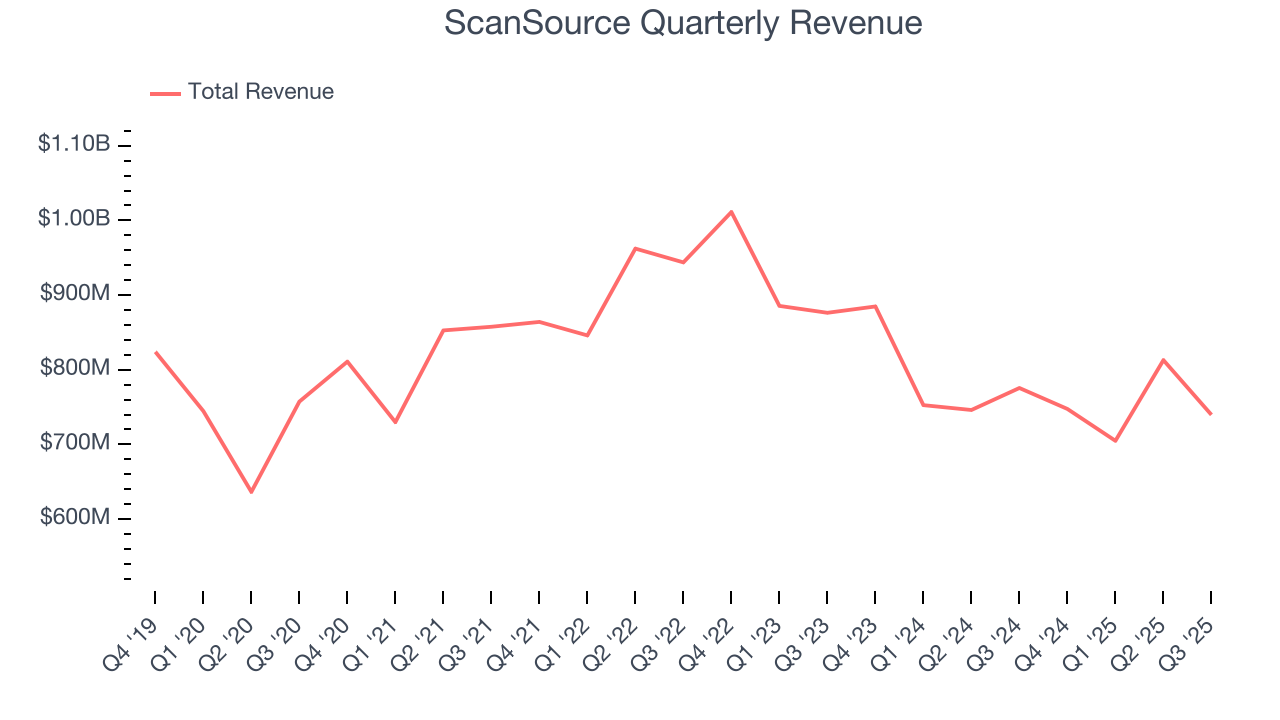
We at StockStory place the most emphasis on long-term growth, but within business services, a half-decade historical view may miss recent innovations or disruptive industry trends. ScanSource’s recent performance shows its demand remained suppressed as its revenue has declined by 11.1% annually over the last two years. 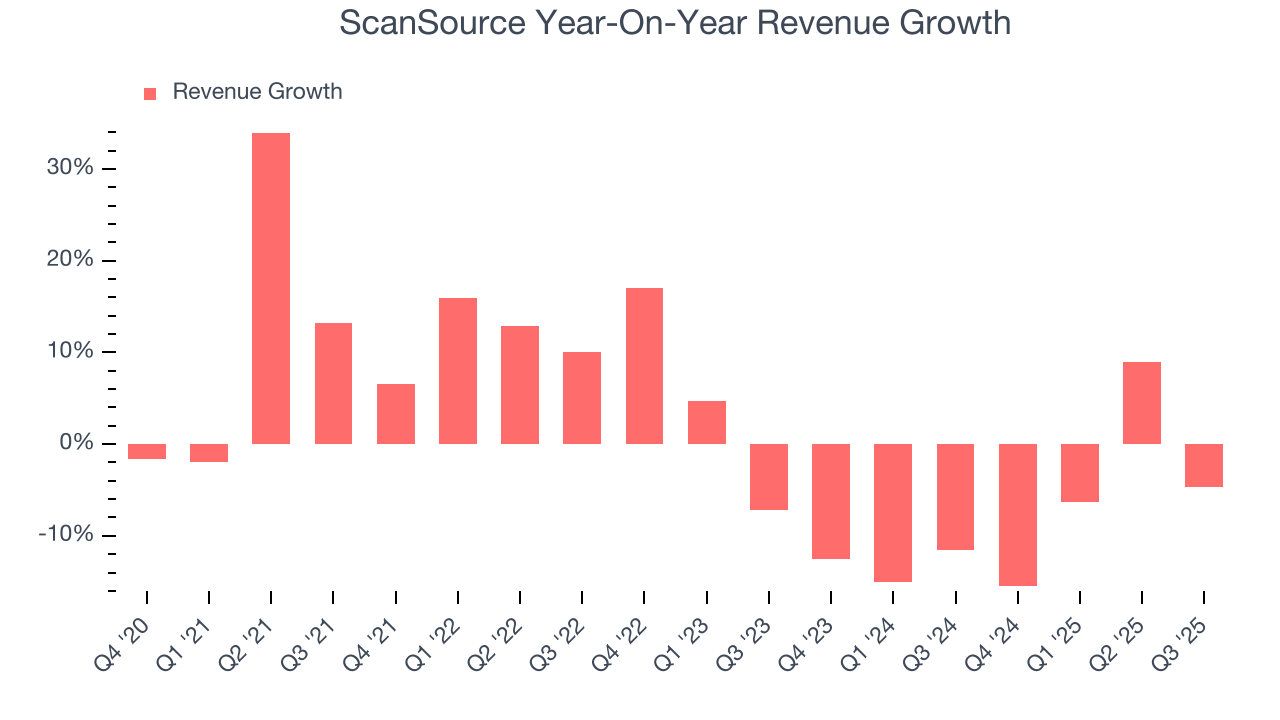
This quarter, ScanSource missed Wall Street’s estimates and reported a rather uninspiring 4.6% year-on-year revenue decline, generating $739.7 million of revenue.
Looking ahead, sell-side analysts expect revenue to grow 6.9% over the next 12 months, an improvement versus the last two years. This projection is above the sector average and suggests its newer products and services will catalyze better top-line performance.
6. Operating Margin
ScanSource’s operating margin might fluctuated slightly over the last 12 months but has remained more or less the same, averaging 3.2% over the last five years. This profitability was lousy for a business services business and caused by its suboptimal cost structure.
Looking at the trend in its profitability, ScanSource’s operating margin might fluctuated slightly but has generally stayed the same over the last five years, which doesn’t help its cause.
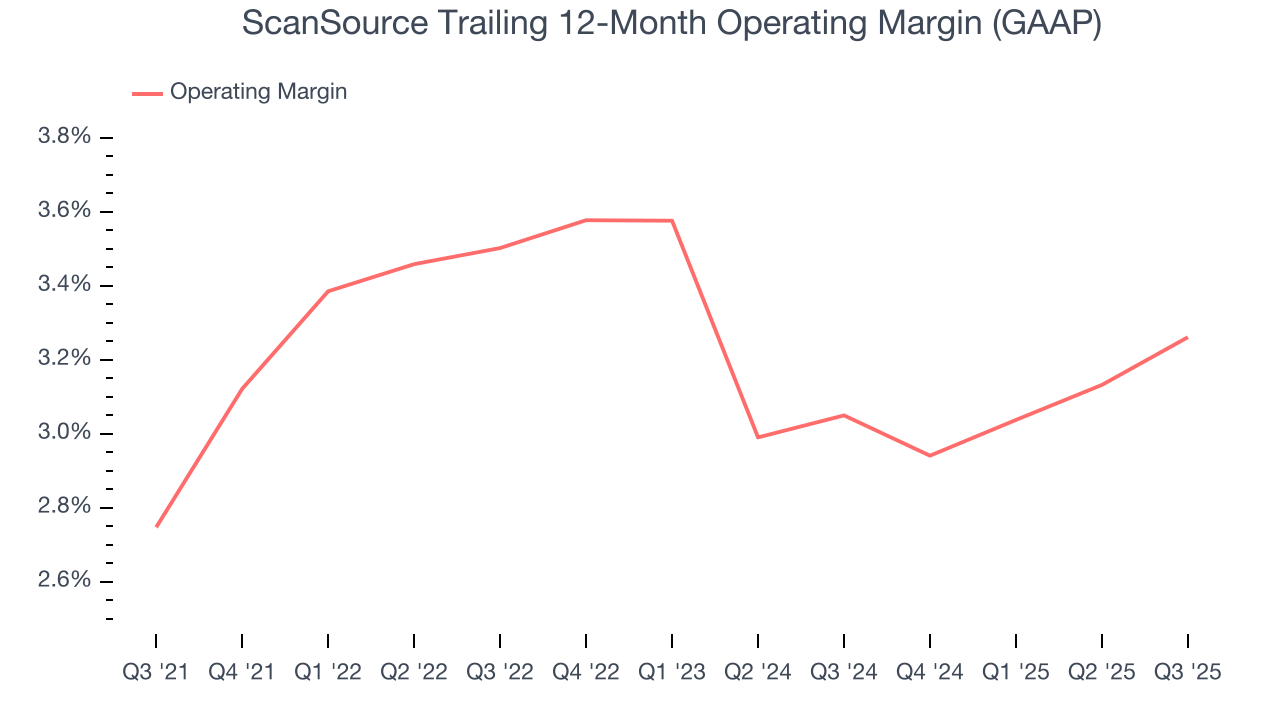
This quarter, ScanSource generated an operating margin profit margin of 3.5%, in line with the same quarter last year. This indicates the company’s overall cost structure has been relatively stable.
7. Earnings Per Share
Revenue trends explain a company’s historical growth, but the long-term change in earnings per share (EPS) points to the profitability of that growth – for example, a company could inflate its sales through excessive spending on advertising and promotions.
ScanSource’s EPS grew at an astounding 16.7% compounded annual growth rate over the last five years, higher than its flat revenue. This tells us management responded to softer demand by adapting its cost structure.
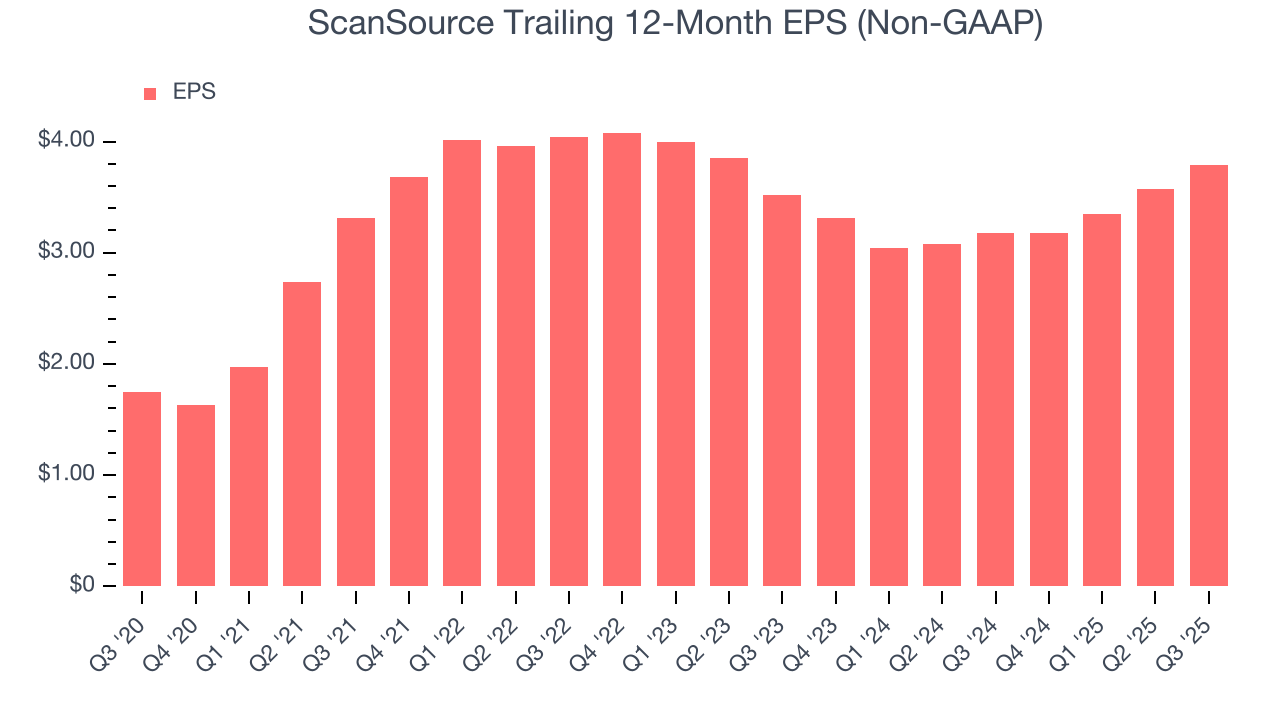
Like with revenue, we analyze EPS over a more recent period because it can provide insight into an emerging theme or development for the business.
For ScanSource, its two-year annual EPS growth of 3.8% was lower than its five-year trend. We hope its growth can accelerate in the future.
In Q3, ScanSource reported adjusted EPS of $1.06, up from $0.84 in the same quarter last year. This print easily cleared analysts’ estimates, and shareholders should be content with the results. Over the next 12 months, Wall Street expects ScanSource’s full-year EPS of $3.79 to grow 10.7%.
8. Cash Is King
If you’ve followed StockStory for a while, you know we emphasize free cash flow. Why, you ask? We believe that in the end, cash is king, and you can’t use accounting profits to pay the bills.
ScanSource has shown weak cash profitability over the last five years, giving the company limited opportunities to return capital to shareholders. Its free cash flow margin averaged 2.6%, subpar for a business services business.
Taking a step back, an encouraging sign is that ScanSource’s margin expanded by 3.4 percentage points during that time. The company’s improvement shows it’s heading in the right direction, and we can see it became a less capital-intensive business because its free cash flow profitability rose while its operating profitability was flat.
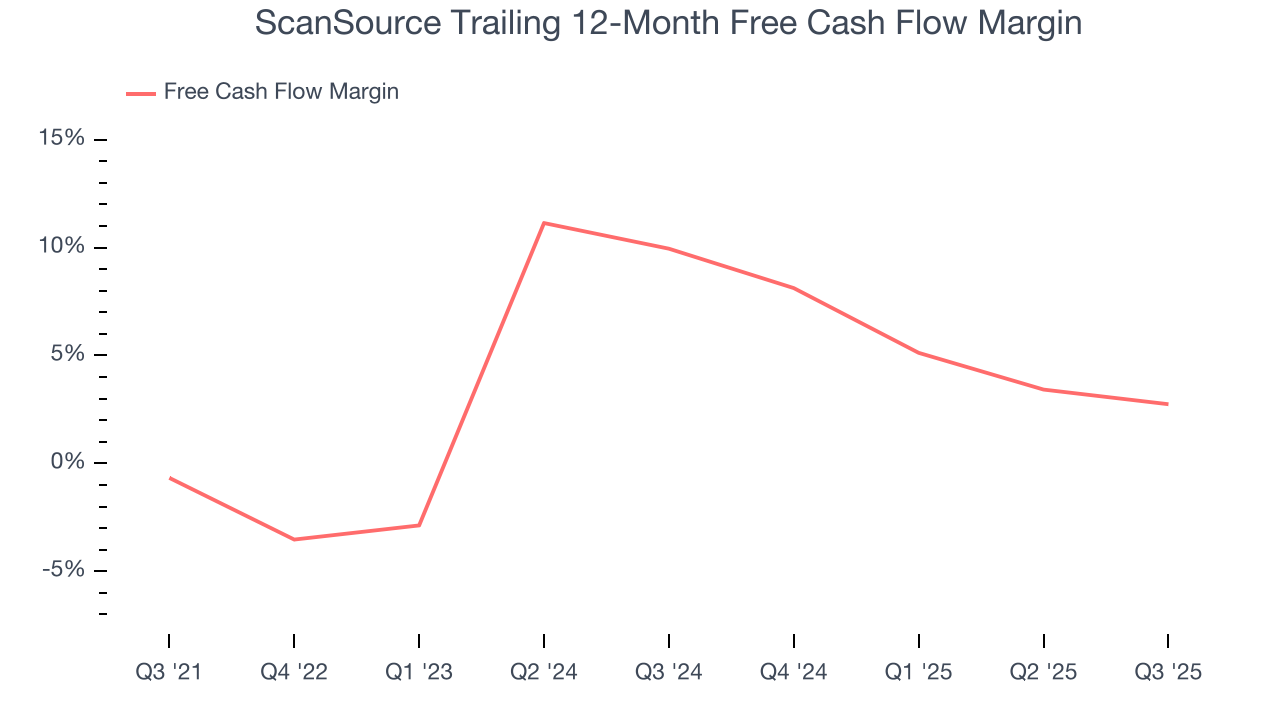
ScanSource’s free cash flow clocked in at $20.82 million in Q3, equivalent to a 2.8% margin. The company’s cash profitability regressed as it was 2.7 percentage points lower than in the same quarter last year, prompting us to pay closer attention. Short-term fluctuations typically aren’t a big deal because investment needs can be seasonal, but we’ll be watching to see if the trend extrapolates into future quarters.
9. Return on Invested Capital (ROIC)
EPS and free cash flow tell us whether a company was profitable while growing its revenue. But was it capital-efficient? Enter ROIC, a metric showing how much operating profit a company generates relative to the money it has raised (debt and equity).
ScanSource historically did a mediocre job investing in profitable growth initiatives. Its five-year average ROIC was 8.4%, somewhat low compared to the best business services companies that consistently pump out 25%+.
We like to invest in businesses with high returns, but the trend in a company’s ROIC is what often surprises the market and moves the stock price. Unfortunately, ScanSource’s ROIC averaged 1.2 percentage point decreases over the last few years. Paired with its already low returns, these declines suggest its profitable growth opportunities are few and far between.
10. Balance Sheet Assessment
ScanSource reported $124.9 million of cash and $133.9 million of debt on its balance sheet in the most recent quarter. As investors in high-quality companies, we primarily focus on two things: 1) that a company’s debt level isn’t too high and 2) that its interest payments are not excessively burdening the business.
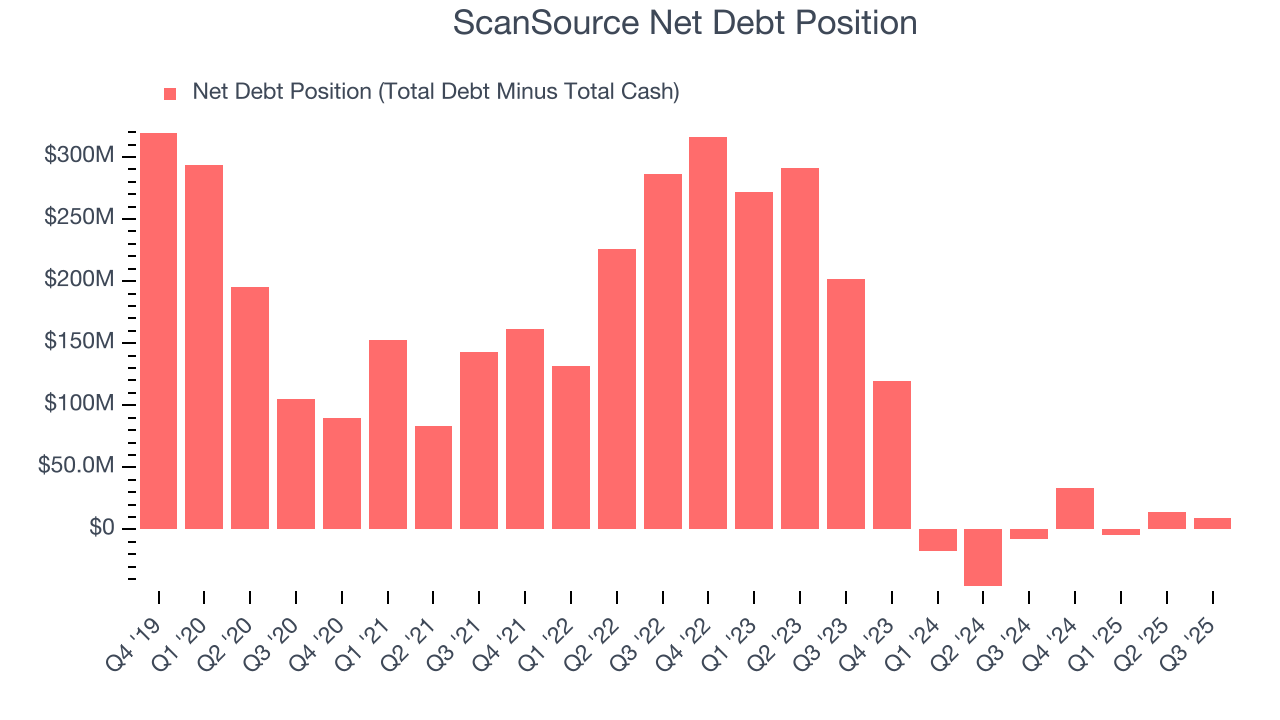
With $146.1 million of EBITDA over the last 12 months, we view ScanSource’s 0.1× net-debt-to-EBITDA ratio as safe. We also see its $4.60 million of annual interest expenses as appropriate. The company’s profits give it plenty of breathing room, allowing it to continue investing in growth initiatives.
11. Key Takeaways from ScanSource’s Q3 Results
It was good to see ScanSource beat analysts’ EPS expectations this quarter. We were also glad its full-year revenue guidance slightly exceeded Wall Street’s estimates. On the other hand, its revenue missed, and this seems to be weighing on shares.The stock traded down 10.4% to $37.50 immediately following the results.
12. Is Now The Time To Buy ScanSource?
Updated: December 4, 2025 at 11:21 PM EST
Before making an investment decision, investors should account for ScanSource’s business fundamentals and valuation in addition to what happened in the latest quarter.
We see the value of companies helping their customers, but in the case of ScanSource, we’re out. For starters, its revenue growth was weak over the last five years. And while its astounding EPS growth over the last five years shows its profits are trickling down to shareholders, the downside is its operating margins reveal poor profitability compared to other business services companies. On top of that, its low free cash flow margins give it little breathing room.
ScanSource’s P/E ratio based on the next 12 months is 9.8x. While this valuation is optically cheap, the potential downside is huge given its shaky fundamentals. There are superior stocks to buy right now.
Wall Street analysts have a consensus one-year price target of $53 on the company (compared to the current share price of $41.36).
Although the price target is bullish, readers should exercise caution because analysts tend to be overly optimistic. The firms they work for, often big banks, have relationships with companies that extend into fundraising, M&A advisory, and other rewarding business lines. As a result, they typically hesitate to say bad things for fear they will lose out. We at StockStory do not suffer from such conflicts of interest, so we’ll always tell it like it is.










